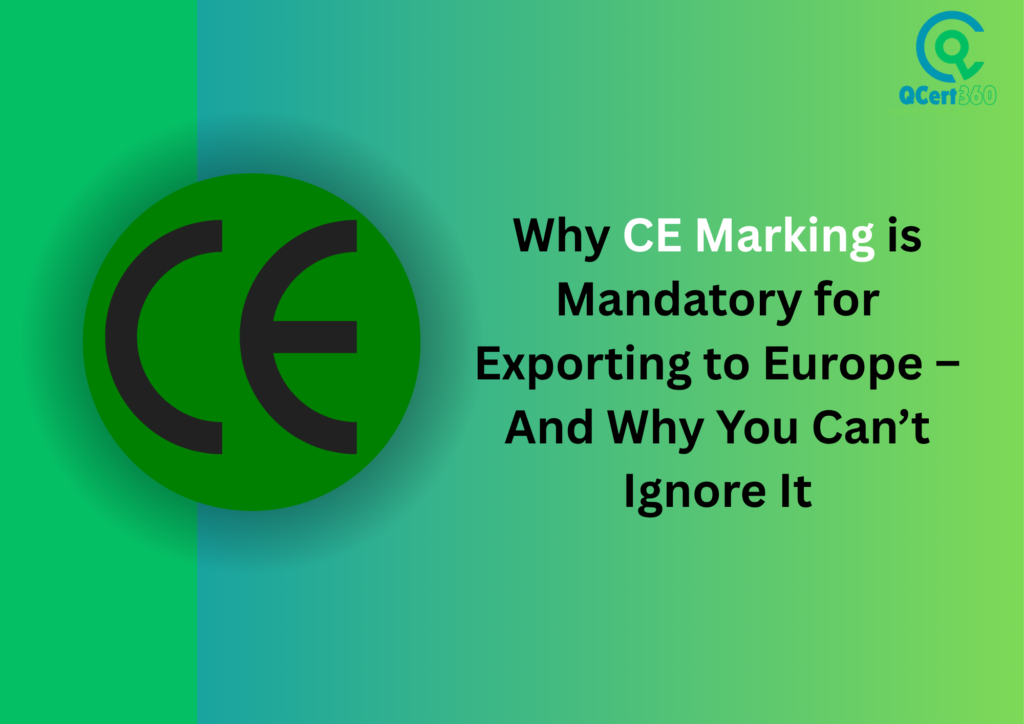Why CE Marking is Mandatory for Exporting to Europe – And Why You Can’t Ignore It

In 2023, a promising electronics company in India eagerly prepared its first shipment of smart gadgets to Germany. The products were innovative, and all seemed set for a smooth entry into the European market—until EU customs halted the shipment. The reason? Missing CE marking. Despite having cutting-edge technology, the shipment couldn’t legally enter the EU. The delay caused significant financial losses—over ₹15 lakhs in logistics, warehousing, and lost contracts—and damaged the company’s reputation as key European distributors pulled out of negotiations. The company had to halt its entire export plan and scramble to meet compliance requirements.
This is not an isolated incident. Many manufacturers and exporters underestimate the legal importance of CE marking when targeting the European market, leading to costly setbacks.
If you’re planning to export or sell products in Europe, there’s one symbol you absolutely cannot overlook: CE Marking. That small, two-letter mark carries enormous legal and business significance. It’s not just a label; it’s your product’s gateway to the European Union.
Whether you’re based in Singapore, Malaysia, UAE, China, Turkey, or any other country outside the European Economic Area (EEA), CE marking is mandatory for certain product categories. Ignoring it can block your entire export strategy and cost your business dearly.
In this comprehensive guide, we’ll cover everything you need to know about CE marking — what it is, why it’s required, who needs it, the certification process, and how QCert360 can help you achieve CE compliance efficiently and confidently.
What is CE Marking?
CE stands for Conformité Européenne, or European Conformity. When a product carries the CE mark, it means the manufacturer declares that the product meets all relevant EU safety, health, and environmental protection requirements.
It’s important to understand that CE marking is not a quality mark. Rather, it’s a mark of legal compliance—your product’s official entry visa to sell in the EU and EEA countries.
Whether you’re exporting children’s toys from India or electronics from China, the CE mark confirms your product adheres to EU laws, enabling free movement across the European market.
Why Is CE Marking Legally Required?
Europe is known for having some of the world’s strictest regulations on product safety and environmental protection. CE marking enforces these standards, ensuring that products sold in Europe are safe, reliable, and environmentally responsible.
Here are the key reasons CE marking is mandatory:
- Protecting Consumers
EU laws require products to meet stringent safety standards, minimizing risks such as electrical shocks, chemical hazards, or mechanical failures. CE marking demonstrates compliance, protecting end-users and building trust.
- Environmental Responsibility
With regulations like RoHS (Restriction of Hazardous Substances) and EcoDesign, CE marking ensures products limit harmful environmental impacts, from toxic materials to energy inefficiency.
- Trade Harmonization
CE marking allows products to move freely across all 27 EU countries plus EEA members (Norway, Iceland, Liechtenstein), eliminating the need for multiple national certifications and reducing trade barriers.
- Legal Obligation
Selling products without the CE mark (when required) is illegal in Europe. Violators risk fines, product recalls, bans, and legal prosecution.
If your export ambitions include major markets like Germany, France, Italy, or the Netherlands, CE marking isn’t optional—it’s an absolute requirement.
Products and Industries That Require CE Marking
CE marking applies to a broad range of products covered by specific EU directives and regulations. Here are some of the main categories:
- Electrical and electronic equipment
- Machinery and industrial equipment
- Medical devices
- Personal protective equipment (PPE)
- Toys and childcare products
- Construction materials
- Gas appliances
- Pressure equipment
- Radio and wireless communication devices
- Measuring instruments
Real-World Industry Examples:
Electronics: An Indian company exporting smartwatches to Germany must comply with the EMC Directive and Radio Equipment Directive. Without CE marking, customs would block their shipments.
Construction: A UAE steel door manufacturer requires CE certification under the Construction Products Regulation (CPR) to supply projects in France and the Netherlands.
Medical Devices: A Malaysian firm producing thermometers and blood pressure monitors must meet the Medical Devices Regulation (MDR) for European healthcare sales.
Toys: A Chinese exporter shipping educational toys to Italy must follow the Toy Safety Directive (2009/48/EC).
PPE: A Turkish glove maker must comply with the PPE Regulation (EU) 2016/425 to sell to hospitals and industrial clients in France, Spain, and Germany.
Gas Appliances: A Moroccan manufacturer of household gas heaters needs CE certification under the Gas Appliance Regulation.
Success Stories:
- Smart Grid Manufacturer, India: After securing CE certification, a Bangalore-based company landed contracts with three major EU utility providers. The CE mark validated compliance with EMC and Low Voltage Directives, boosting customer trust.
- Eco-Friendly Adhesives, Egypt: Earning CE marking helped this company break into Scandinavia’s sustainable building materials market, where strict environmental compliance is essential.
- Drone Startup, Turkey: CE certification accelerated market entry in Germany and France, winning key distribution deals and helping the startup establish credibility for safety and innovation.
These examples prove that CE marking isn’t just compliance—it’s a business advantage that opens doors to Europe’s vast and lucrative markets.
What Happens If You Skip CE Certification?
Skipping CE marking to save time or costs is a risky gamble. Consequences include:
- 🚫 Confiscation of shipments at EU customs
- 💸 Hefty fines for non-compliance
- 🔁 Expensive product recalls
- ❌ Market bans preventing sales in Europe
- 🤯 Loss of trust from distributors and customers
- 📉 Damage to brand reputation in global markets
No matter your product, ignoring CE marking risks your entire export operation and long-term business growth.
The CE Certification Process – Step-by-Step
Achieving CE compliance involves a clear, systematic approach:
Step 1: Identify Relevant EU Directives and Standards
Start by pinpointing which EU directives apply to your product category, such as:
- EMC Directive (electronics)
- Machinery Directive
- Toy Safety Directive
- Medical Devices Regulation (MDR)
- PPE Regulation
Step 2: Conduct a Conformity Assessment
- Self-certify for low-risk products.
- Involve a Notified Body (third-party certification body) for higher-risk or regulated items (e.g., medical devices, PPE).
Testing may include safety, durability, environmental impact, and electromagnetic compatibility.
Step 3: Compile Technical Documentation
Prepare a comprehensive technical file with:
- Product specifications and drawings
- Manufacturing process descriptions
- Risk assessments and test results
- User instructions and safety warnings
- Labeling and packaging details
This documentation must be retained for at least 10 years.
Step 4: Draft the EU Declaration of Conformity (DoC)
This legally binding statement confirms your product meets all applicable EU rules. It includes:
- Product identification
- Manufacturer’s details
- Applied directives and standards
- Signature of an authorized representative
Step 5: Affix the CE Marking
After meeting all requirements, apply the CE mark visibly and legibly on the product, packaging, or accompanying documents.
How QCert360 Helps You Get CE Mark Certified
Navigating CE certification can be complex, especially if it’s your first time. That’s where QCert360 comes in.
We help businesses across India, UAE, Africa, Southeast Asia, and beyond achieve CE compliance efficiently and hassle-free.
Benefits of Getting CE Marking
CE certification unlocks significant business opportunities. Let’s explore these benefits with real-world scenarios:
Benefit | Description & Example |
🌍 Unrestricted EU Market Access | Export once, sell across 30+ countries without separate national certifications. Example: Bengaluru startup scaled quickly across Germany, Spain, and Sweden with one CE mark. |
📈 Increased Customer Trust | CE mark signals product safety, boosting sales. Example: Turkish PPE maker quadrupled sales during the pandemic after CE certification. |
🤝 Stronger Business Partnerships | Distributors require CE compliance. Example: UAE LED lighting company secured contracts with 5 major European wholesalers post-CE certification. |
🔐 Legal and Regulatory Protection | Avoid fines and seizures. Example: Nigerian thermometer exporter cleared customs seamlessly after CE compliance. |
🚀 Global Market Recognition | CE standards respected worldwide. Example: Malaysian medical gloves gained demand in Saudi Arabia, South Africa, and Indonesia after CE marking. |
Final Thoughts: Don’t Let CE Marking Be an Afterthought
Whether you’re a startup or an established manufacturer, CE marking should be a priority—not a last-minute task. It’s not just about entering Europe; it’s about doing so legally, confidently, and competitively.
CE certification provides you unrestricted market access, increased credibility, stronger partnerships, and vital legal protections.
With QCert360 as your trusted partner, you’ll receive expert guidance through every step of the CE certification journey—making compliance clear, manageable, and efficient.
Wherever you operate—India, UAE, Africa, or Southeast Asia—getting CE certified is your gateway to thriving in Europe and beyond.
📞 Start your CE certification journey now: +91 7483870406
📧 Or email us at contact@qcert360.com
QCert360 — Certify Smart. Export Global.
Our comprehensive services include:
✅ Directive and standards identification tailored to your product
✅ Coordination with accredited labs and Notified Bodies for testing
✅ Preparation and review of all technical documentation
✅ Packaging and labeling compliance checks
✅ Audit support and guidance through conformity assessments
✅ Ongoing post-certification assistance to maintain compliance
📞 Ready to get CE certified? Call +91 7483870406
📧 Or email contact@qcert360.com
Let us take the guesswork out of your EU compliance journey and accelerate your path to market success.


